|
The first written reference
to Bescot is an entry in the Domesday Book in
which it is called “Bresmundescote” and is
described as a single carucate of land largely
lying waste. A carucate was the area of farming
land that could be ploughed by one oxen team in
a year. It is usually considered to be about 120
acres.
The first known residents
of Bescot were the Hillary family who came from
Saint-Hilaire-du-Harcouët,
in Normandy and were given land by the King in
return for their assistance in the Norman
invasion. By 1271, Bescot was held by William
Hillary, who acquired more land in the area. The
area became known as Bescot Manor, which was
ruled by William Hillary who was lord of the
manor.
There was a hall at Bescot
by 1311 which would have been occupied by the
Hillary family. In that year, William took legal
action against some of his neighbours who were
accused of raising a mob of about 49 men and
causing chaos around the hall. They were accused
of beating his workers, stealing goods and
laying siege to the house, where they fired
arrows at the windows and doors and prevented
the occupants from leaving the house for a
considerable time.
William claimed one hundred
pounds in damages against Thomas Le Rous, Roger
Bassett and three others. At the time the
Hillarys were unpopular with their neighbours
and constantly in dispute with them. By 1345 the
hall had been fortified with a wall complete
with battlements and slots from where arrows
could be fired. There was also a rectangular dry
moat that was double- ditched on its
north-western side. Before the end of the
century a chapel was added to the hall.
|
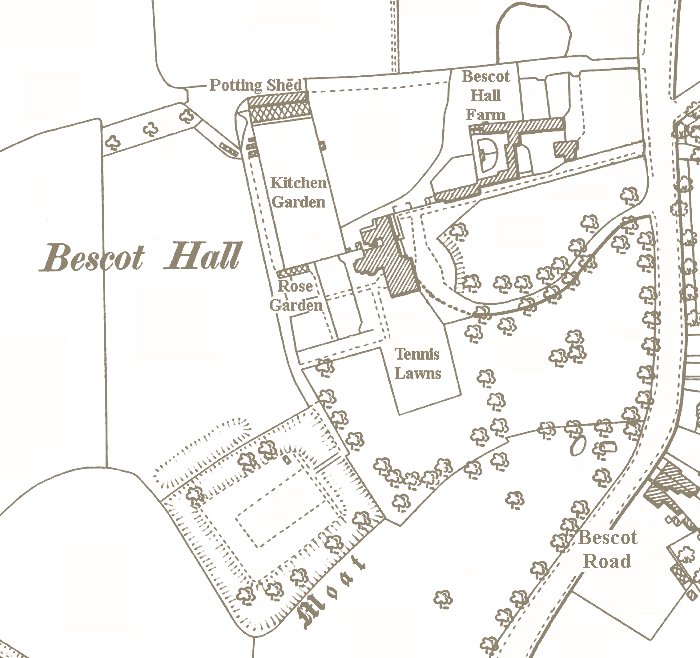
Bescot Estate in the 20th
century, with the site of the original hall on
the left and the 18th century replacement on the
right. |
|
In 1411 the hall passed-on
to William Mountfort, of Coleshill,
Warwickshire, who was a great-grandson of one of
the Hillarys and a descendant of Simon de
Montfort, who rebelled against King Henry III in
1263. The Mountfort family were in residence for
nearly three hundred years and the hall and
estate was passed from father to son for several
generations.
On the 30th January, 1469,
William's grandson, Sir Simon Mountfort (also
known as Sir Simon Mountford) was found guilty
of treason and executed. His estates were
forfeited. In 1534 when Bescot estate was
returned to the family, his grandson, Thomas
Mountfort took over. In 1586, Queen Elizabeth
stayed at the hall and while there signed
several documents relating to Walsall.
The 17th century was a
turbulent time for the family. In 1605 the
Mountforts became Catholics, at a time when the
Catholic Church was regarded with suspicion. The
Act of Uniformity, Passed in 1559 required
people to attend Church of England services.
Because of the Mountfort’s refusal to join the
Church of England, their estate at Bescot was
sequestered (seized by the government) in 1648.
The family remained staunch Catholics and by
1652 had managed to lease back two thirds of the
estate. The following year the Mountforts
managed to lease back the remaining third of the
estate.
By 1671 the Mountforts kept
a Catholic priest at the hall, named Francis
Dormer who held Catholic mass there. He had been
a trustee of the Mountforts, and was executed at
Worcester in 1678. Simon Mountfort died in
1664 and was succeeded by his brother Edward.
Edward died in 1672, leaving two children, Simon
and Elizabeth, both minors. Simon died and the
manor was inherited by Edward's widow Elizabeth.
By this time the hall was
an impressive building, as can be seen from the
Hearth Tax records. The tax (from 1662 to 1689)
ensured that each liable
householder had to pay one shilling, twice a
year, for each fire hearth and stove in each
dwelling. The hall had 14 hearths and 14
rooms and two pools (Over Pool and Great Pool)
which were well-stocked with eels and water
fowl.
Elizabeth Mountfort died
around 1675 and the estate passed into the hands
of trustees. In the early 1680s Edward and
Elizabeth Mountfort’s daughter, Elizabeth,
married Thomas Harris. His father, who had the
same name, was Elizabeth’s guardian. He had
acquired the estate, which was passed on to his
son and Elizabeth on their marriage. Elizabeth’s
husband, Thomas, died and she married Jonas
Slaney, who had died by 1727.
|
|
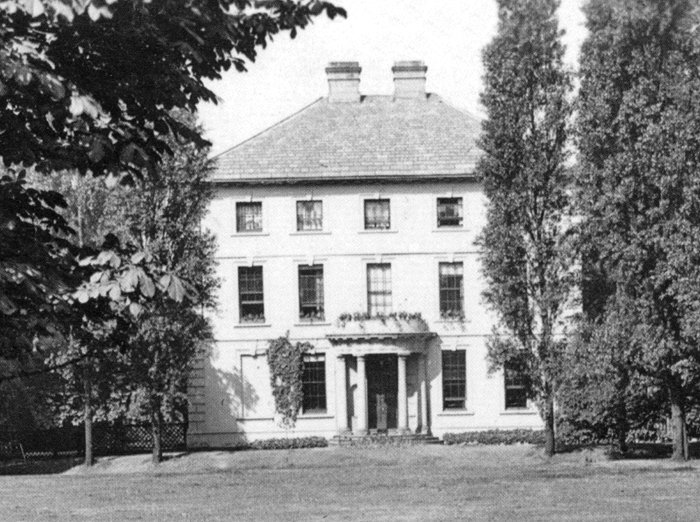
The 18th century hall
in the 1920s. |
|
The Slaneys became the next
major residents of Bescot and it was during
their occupation that the second Bescot Hall was
built. Jonas Slaney’s grandson, Jonas, inherited
the hall and estate in 1762 or 1763. He had been
living at Bescot for some time, but in 1768 he
moved to Bristol and stayed there for several
years. By 1772 he had returned to Bescot and by
1778 was vicar of Rushall and also a magistrate.
By 1781 he was in deep financial trouble and was
forced to hand over the estate to trustees.
The new Bescot Hall was an
elegant, well built, two storey mansion house,
with an attic and six rooms on the first floor.
The old hall was demolished and the site was
laid out as a garden, with a stone bridge over
the moat. There were walled gardens around the
new hall which contained a variety of fruit
trees. There were also barns, a malthouse,
stables and a coach house for four carriages.
Nearby was Bescot Hall Farm.
In 1778, Richard Wilkes
moved into the hall and in 1791 purchased it,
along with 80 acres of land for £3,200. In 1794
he sold the property and land to Richmond Aston,
a Tipton banker, for £4,000. Much of his wealth
came from Black Country coal mines. He began to
enlarge the hall, adding a third storey and a
semi-circular porch with Tuscan columns at the
entrance.
After his death in 1796,
his widow continued to extend the building,
adding a second storey to the wing and at the
rear, an annexe with a basement and a
conservatory. She lived at the hall until at
least 1800, but by 1820 the estate was owned by
Richmond Aston's trustees, who then sold it to
Edward, Stephen, and John Crowther. By 1843 John
Crowther was sole owner. In 1852 he left the
property to William Crowther, a relative. The
Crowthers did not live at Bescot, so the hall
was occupied by a succession of tenants.
William Crowther died in
1865 and the estate was in the hands of
trustees. In October 1871 it was split up and
sold. Richard Bagnall, who was living at the
hall agreed to buy it, but in April 1872 it was
purchased by James Slater, a solicitor from
Darlaston who was married to Elizabeth, daughter
of Darlaston industrialist Samuel Mills. They
had five sons and six daughters. James and
Elizabeth lived there for the rest of their
lives.
|
|
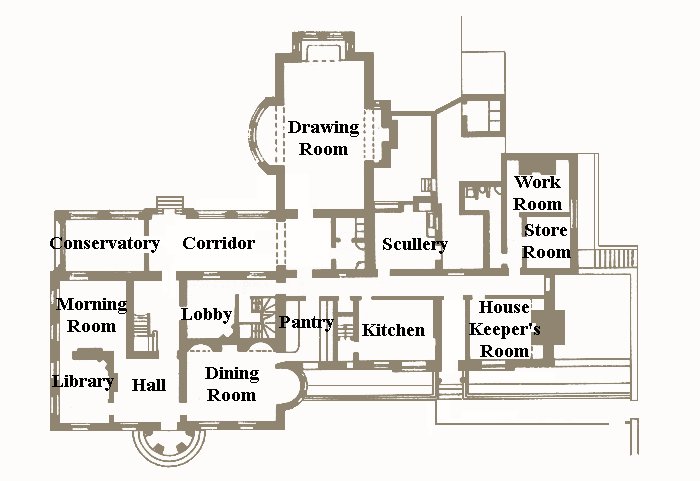
A ground plan of the
hall in 1922 when the house was on sale
after Elizabeth Slater's death. |
|

The drawing room,
showing the Slater's opulent lifestyle. |
|
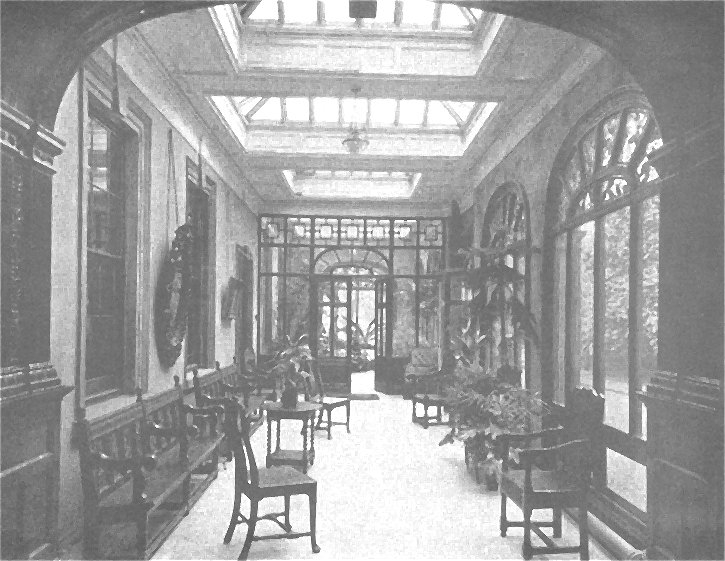
The Conservatory. |
|

The hall in the
early 20th century. |
|
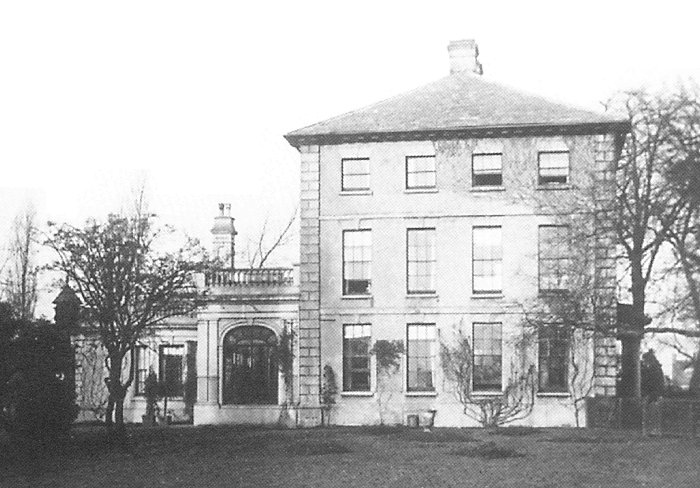
Another 20th century
view. From an old postcard. |
|
James Slater was a J.P. who sat on
the Willenhall Bench for many years and was a
major shareholder in John Harper & Company of
Willenhall. He was also a churchwarden at St.
Lawrence's Church in Darlaston, a member of Darlaston's first School Board, formed in 1883,
and in 1888 Chairman of the Local Board at
Darlaston. Slater Street in Darlaston and Slater
Street in Willenhall are both named after him.
James died at the house on
the 26th October, 1901, and the estate passed to
the following trustees: his widow Elizabeth, and
sons Samuel Mills Slater, and Edward Tilley
Slater. In his will it is valued at
£61,311.4s.8d. which is about £3.5 million in
today's money. The family must have had an
extremely opulent life style.
After Elizabeth's death in
April 1922 the house remained empty for a while before
it was purchased by Pitt Bonarjee, a
Congregational minister at Wednesbury, who
opened the house as a private school. In 1929 to
1930 the house was demolished, and the land sold
in several plots. The bridge over the moat that
surrounded the original hall was in a bad state
of repair and so was demolished in 1937.
The site is now occupied by
the houses in Montfort Road and Bescot Drive,
the remainder of the estate is now part of Pleck
Park.
|
 |
Return to
the
previous page |
|